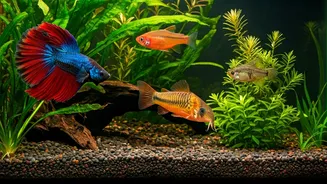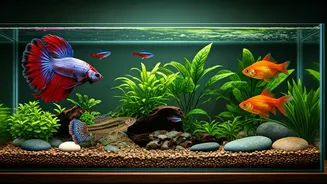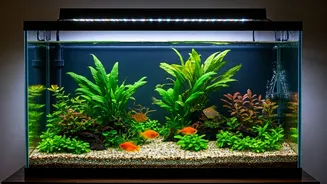Introduction to Aquariums
Setting up an aquarium can be a fantastic hobby that brings a touch of nature indoors. Before diving into the specifics of fish, it's essential to understand
the basics of aquarium setup. This involves selecting an appropriately sized tank, choosing a suitable filter and heater to maintain water quality and temperature, and deciding on substrate, decorations, and lighting to create a visually appealing environment. Proper planning and research are crucial for establishing a healthy and thriving aquatic ecosystem where your fish can flourish. Investing time in the initial setup will contribute significantly to your aquarium's long-term success, ensuring your fish live in a comfortable and stable environment. Regular water changes and monitoring water parameters are crucial for fish health.
The Peaceful Betta
Betta fish, also known as Siamese fighting fish, are popular choices for beginners due to their vibrant colors and relatively low maintenance needs. They are labyrinth fish, meaning they can breathe air from the surface, allowing them to survive in smaller tanks without a powerful aeration system. A single Betta can thrive in a 5-gallon tank, but avoid housing multiple males together as they are highly territorial and will fight. Betta fish have diverse personalities, so observe them to identify their preferences, such as hiding spots or a specific type of food. Bettas thrive on a diet of high-quality betta pellets, supplemented with occasional treats like bloodworms or brine shrimp. Maintaining a consistent water temperature of around 78-80°F (25-27°C) and performing regular water changes will keep your Betta happy and healthy.
The Hardy Guppy
Guppies are another excellent choice for beginners, known for their adaptability and prolific breeding habits. They come in an array of colors and patterns, making them visually appealing. Guppies can be kept in community tanks with other peaceful fish, such as Corydoras catfish, provided the tank is large enough to accommodate the population growth. Guppies are livebearers; females give birth to live fry, so be prepared for a growing population. They are not very demanding in terms of water parameters, but prefer a slightly alkaline pH of 7.0-7.5. These fish are relatively easy to feed, accepting flake food, and small amounts of live or frozen food like daphnia or brine shrimp. Regular partial water changes are essential to maintain water quality and prevent diseases, making the guppy a hassle-free addition to any home aquarium.
The Friendly Corydoras
Corydoras catfish, often called Corys, are peaceful bottom-dwellers that add a dynamic element to any community tank. These fish are known for their active foraging behavior, constantly sifting through the substrate in search of food. Different species of Corys vary in size, but most can be kept in a tank of 10 gallons or more. They are sociable fish and thrive when kept in groups of at least six. Provide a sandy substrate, as they are prone to damaging their barbels on sharp gravel. These catfish will eat various foods like sinking pellets, flakes, and occasional live or frozen foods. Maintaining a well-oxygenated environment and keeping the water clean is important for their health. Corydoras are hardy and can withstand various water conditions, making them a good option for novices.
The Colorful Platy
Platies are robust and colorful live-bearing fish that are perfect for beginners. They are available in many different varieties and can thrive in a community tank environment. Platies are easy to care for and enjoy a varied diet of flake food, vegetables, and occasional live or frozen treats. They are active swimmers and prefer a well-planted tank with plenty of open space for movement. They breed easily, so it's a good idea to consider the tank's capacity to accommodate the fry, or the fry may need to be moved to a separate breeding tank. Platies do well in tanks with a pH between 7.0-8.0, and a temperature range of 72-78°F (22-26°C). These vibrant fish are not only visually appealing but also offer engaging behavior, making them excellent choices for anyone setting up their first aquarium.





